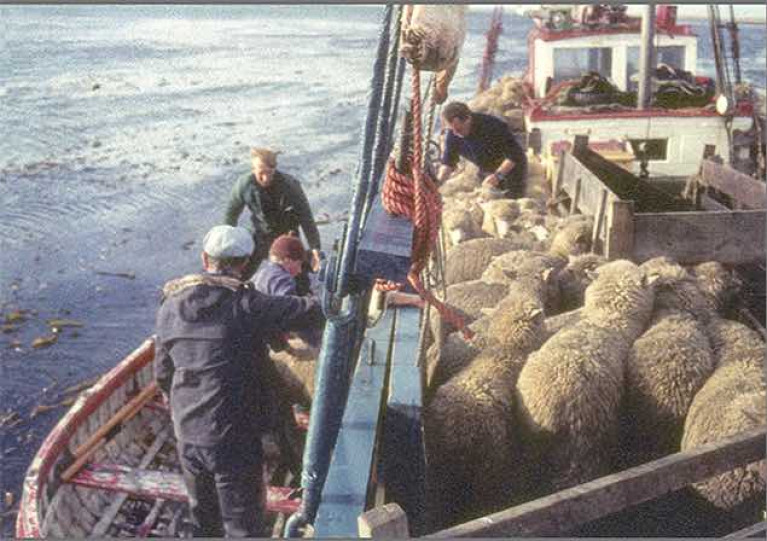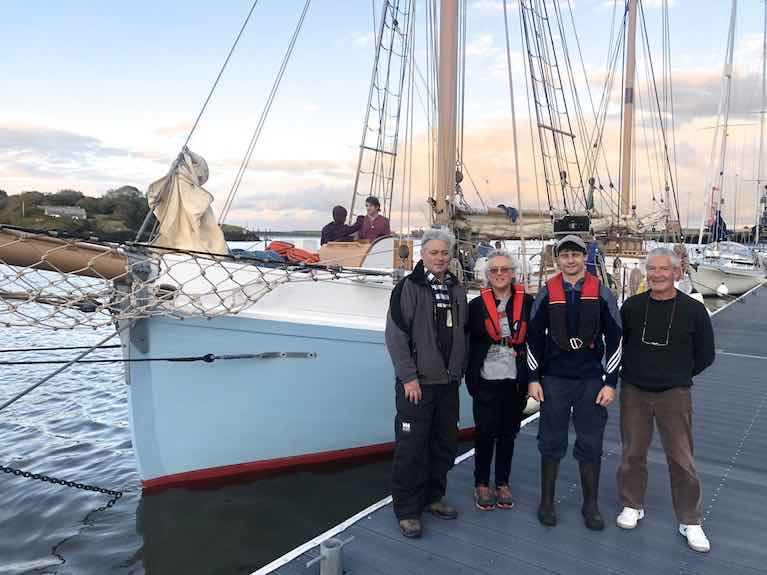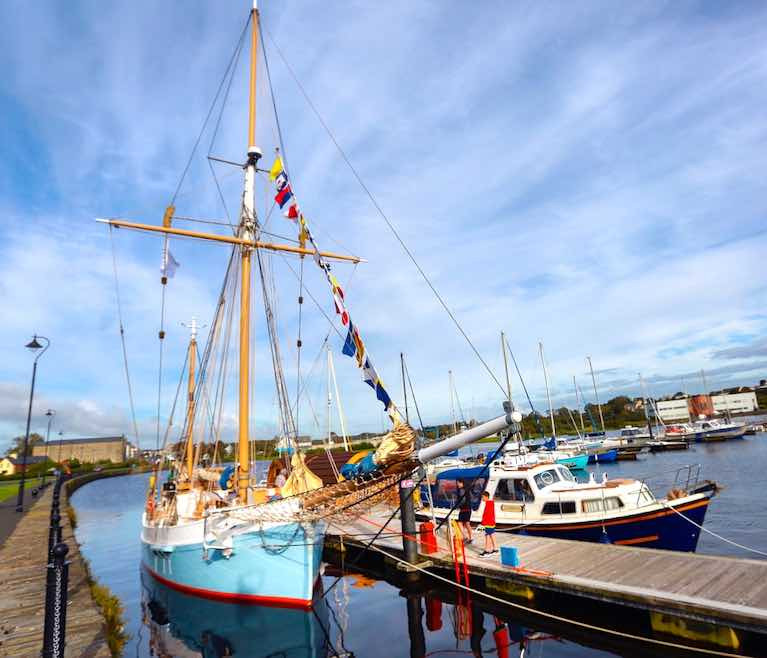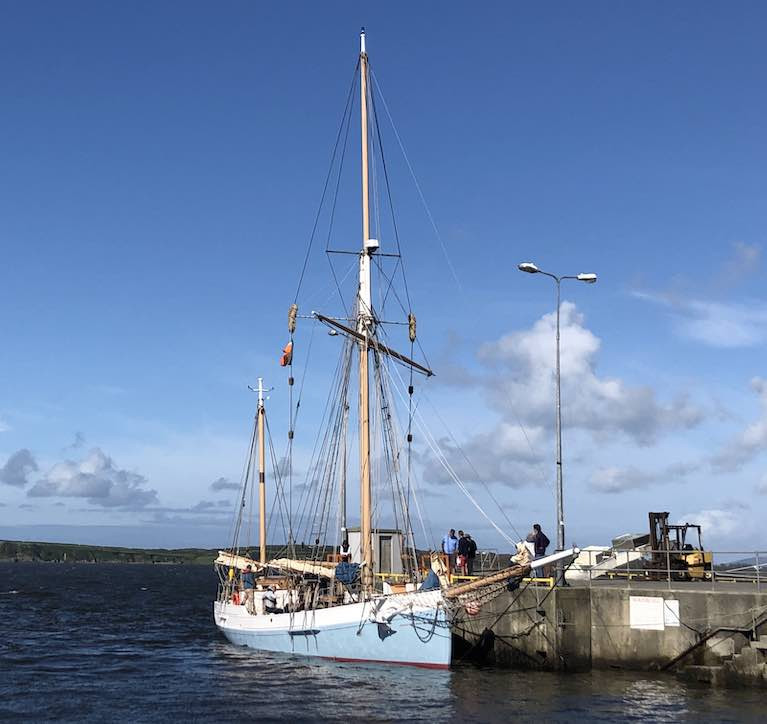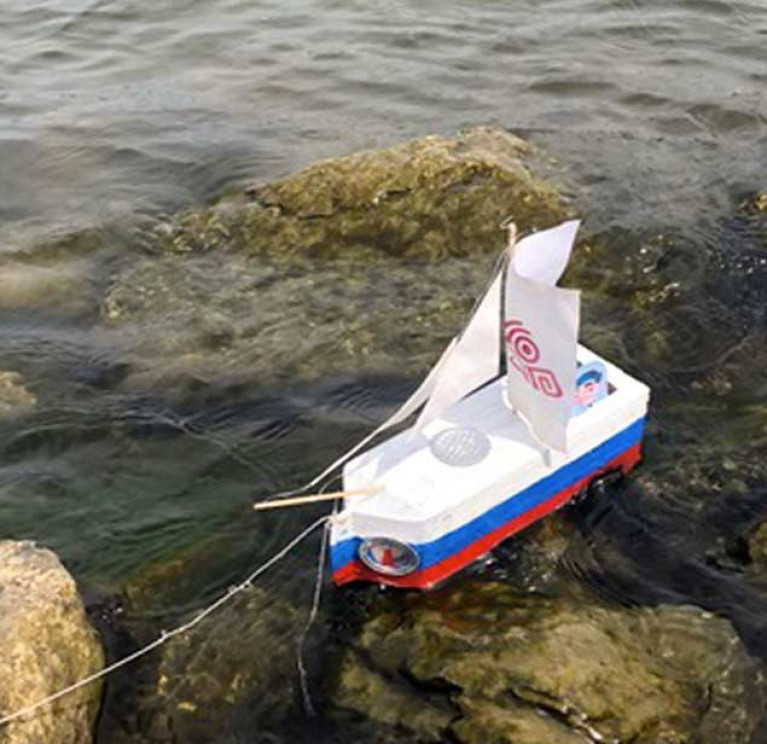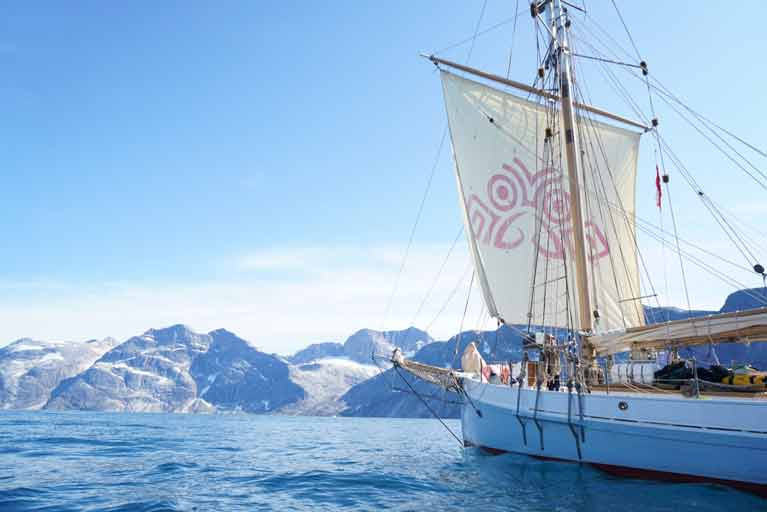Displaying items by tag: Ilen
Ireland's Last Trading Ketch Becomes Ilen Marine School
When the 56ft Conor O'Brien-designed trading ketch Ilen - built in Baltimore in West Cork in 1926 - was retrieved and brought back to Ireland by Gary MacMahon of Limerick from the Falkland Islands in November 1997, it was the beginning of a long process of restoration and preparation for seagoing, a process which came under several different headings, all of them within the umbrella title of The Ilen Project.
While the rebuild project was centre stage over many years, it was known as the Ilen School and Network For Wooden Boat-Building. There was a twin focus on the Ilen Boat-building School in Limerick - where many significant parts such a deckhouses were built in addition to several small craft - and on Hegarty's Boatyard at Oldcourt on the Ilen River above Baltimore, where Liam Hegarty and his craftsmen on the main job were from time to time joined by noted international shipwrights from abroad who appreciated the opportunity to work in completely traditional style.
Once the ship was sailing in the late summer of 2018, she began to move towards a sea training and cultural emphasis, and for the first part of the 2019 season she was active from Kinsale under the command of James Lyons, working very effectively within the Sailing Into Wellness programme. Then as July 2019 approached, she was re-focused to become a sailing ambassador to West Greenland on an impressive ocean voyage from Limerick under the Salmons Wake banner, as 2019 was the Year of the Atlantic Salmon, and the journey of Ilen to Greenland, and her extended presence there, provided direct lines of cultural inter-action between schoolchildren in Limerick and Clare, and the schoolchildren of Greenland.
 Test marketing for a re-branding process – the new Ilen Marine School T-shirt makes its debut in saluting the ship at Kilrush. Photo: Gary Mac Mahon
Test marketing for a re-branding process – the new Ilen Marine School T-shirt makes its debut in saluting the ship at Kilrush. Photo: Gary Mac Mahon
Returning from Greenland as the Autumn of 2019 approached, she shaped her course directly for Kinsale and further work with Sailing into Wellness while the outline of plans for 2020 were being sketched out around a possible voyage to Madeira, a key port of call for Conor O'Brien when he sailed Ilen to the Falklands in 1926.
However, the pandemic put paid to that, but the brief summertime lifting of restrictions did enable Ilen to undertake a Community & Cargo Voyage, delivering artisan products from Cape Clear, Baltimore, Kinsale, Cork, Kilrush, Foynes, Limerick, Kilronan in the Aran Islands and Dingle among specialist and general outlets along the way.
It was while Ilen was in Kilrush in late August during this intriguing cargo voyage that the process began of moving her into the next stage of her continuing metamorphosis, as the crew appeared on deck wearing the new Ilen Marine School T-shirts, and the handsome dark blue Ilen Marine School ensign went aloft.
The name "Ilen Marine School" has actually been in being since 2000, but as is the way of this longterm project, director Gary Mac Mahon felt that the ship and the Ilen Trust guiding her had to fulfill certain objectives afloat and ashore before the official changeover process could begin.
These things take time, and while Ilen may have returned to deliver the last of her cargoes to Kinsale in early September displaying some of the symbols of the developing Ilen Marine School, it is only now that the paperwork is nearing completion, and on Bank Holiday Monday she took her first sail in her new role.
 Ilen's accommodation has been upgraded in recent weeks. Photo: Gary Mac Mahon
Ilen's accommodation has been upgraded in recent weeks. Photo: Gary Mac Mahon
In the meantime, the crew of Mike Grimes, Mantas Seakauskis, Frank O'Sullivan and Jim McInerney have been busy re-activating their boat-building and finishing skills to bring Ilen's accommodation up to a standard which is a very long way indeed from her role for sixty years as the sheep ferry in the Falkland Islands. Indeed, it is a different world altogether from the "Arts & Crafts Floating Cottage" interior which Conor O'Brien and his wife Kitty Clausen created in the accommodation of Ilen's predecessor, the world-girdling Saoirse.
 Ilen's shiny new-look saloon will make for a fascinating comparison…
Ilen's shiny new-look saloon will make for a fascinating comparison…
 ….with the Arts & Crafts concept of Saoirse's saloon, as captured by Kitty Clausen, with Conor O'Brien at the saloon table
….with the Arts & Crafts concept of Saoirse's saloon, as captured by Kitty Clausen, with Conor O'Brien at the saloon table
The work of re-building Saoirse continues at Oldcourt with Liam Hegarty and his team, and in due course we'll see how close to that iconic Saoirse saloon the sailors of 2021 (or maybe 2022) can hope to reach.
Meanwhile, the name "Ilen Marine School" will ring bells for connoisseurs of the famous James Malton prints of Dublin in the 1790s, one of the most famous being his 1796 depiction of the impressive purpose-built Marine School on the south quays of the Liffey. The idealism of the city fathers in creating an educational establishment to produce competent seamen and ship's officers seems to have been an ambition which was too good to last, as the Marine School was to fade away over time.
 An idea ahead of its time – the Marine School (left) in Dublin, as recorded by James Malton
An idea ahead of its time – the Marine School (left) in Dublin, as recorded by James Malton
It continued for a while in replacement premises in Clontarf, and then it was subsumed into Mountjoy School for Boys, which in turn was amalgamated with Temple Girls School to become Mount Temple School in Clontarf, leaving only the faintest trace of memories of the old marine school. Nowadays, Mount Temple is best known as the alma mater of U2. We can only guess at what unexpected talent may emerge from the Ilen Marine School…….
 The last traces of the Marine School in Dublin are now to be found in Mount Temple School, which has in recent decades encouraged some remarkable talents
The last traces of the Marine School in Dublin are now to be found in Mount Temple School, which has in recent decades encouraged some remarkable talents
West Cork Mini-Workboat Was a Key Link in Ilen's South Atlantic Shepherd Role
When we contemplate the 56ft 1926-vintage Limerick ketch Ilen today in her superbly-restored form, making her stylish way along rugged coastlines and across oceans on voyages of cultural and trading significance between places as evocative as Nuuk in West Greenland and Kilronan in the Aran Islands, we tend to forget that for 64 years this Conor O'Brien-designed Baltimore-built ketch worked very hard indeed as an unglamorous yet vital inter-island link in the Falklands archipelago.
In that rugged environment, she was, of course, the inter-island passenger boat. But she could also be relied on to bring urgently-needed supplies - including medicines - to some very remote settlements, and a regular commuter on board was the "travelling schoolteacher", who was the only link to structured education for the children of families running distant island sheep-stations.
 With many islands lacking proper quays, the Ilen's punt was an essential part of the sheep delivery route. Here, it's 1974, and Ilen skipper Terry Clifton starts the Seagull outboard while Gerald Halliday (forward) holds Ilen's chain bobstay, and third crew Stephen Clifton finds it is standing room only among the paying passengers. Photo courtesy Janet Jaffray (nee Clifton).
With many islands lacking proper quays, the Ilen's punt was an essential part of the sheep delivery route. Here, it's 1974, and Ilen skipper Terry Clifton starts the Seagull outboard while Gerald Halliday (forward) holds Ilen's chain bobstay, and third crew Stephen Clifton finds it is standing room only among the paying passengers. Photo courtesy Janet Jaffray (nee Clifton).
But while the people were important, ultimately the sheep were what it was all about, such that from time to time Ilen Project Director Gary Mac Mahon receives historic photos which underline this aspect of Ilen's working life.
And in case there had been any doubt about it, after Ilen was shipped back to Ireland in November 1997, she spent the winter in the Grand Canal Basin in Dublin being prepared to sail back to Baltimore in the early summer of 1998, a target which was met.
But, as ruefully recalled by Arctic ocean circumnavigator and traditional boat enthusiast Jarlath Cunnane of Mayo, one of the volunteers who worked on Ilen through that winter, the toughest and most necessary job had nothing to do with setting up the rig. On the contrary, it was the removal of the accumulated and impacted evidence of 64 years of ovine occupation from the hold.
 Ilen in the Falklands at George Island jetty in 1948, with the punt astern. The photo is by John J Saunders, who was the "Travelling Teacher" among the islands
Ilen in the Falklands at George Island jetty in 1948, with the punt astern. The photo is by John J Saunders, who was the "Travelling Teacher" among the islands
 Ilen as we know her today, stylishly restored and seen here sailing off the coast of Greenland, July 2019. Photo: Gary Mac Mahon
Ilen as we know her today, stylishly restored and seen here sailing off the coast of Greenland, July 2019. Photo: Gary Mac Mahon
Yet being in that hold or on deck was only part of it for the sheep in their travelling around the islands, for many of those islands lacked proper quays. So in getting the sheep ashore, it was often vital to have a handy, robust and seaworthy ship's punt which – like Ilen herself - had to be versatile in moving easily when lightly laden, while still being more than capable when heavily laden with stores and sheep and people, and often all three together.
 Ilen and her punt, with a float of kelp drifting past in classic Falklands style. While the little boat may look ruggedly workaday, there's real functional elegance here, with the transom well clear of the water to allow ease of progress when un-laden, allied to proper load-carrying power
Ilen and her punt, with a float of kelp drifting past in classic Falklands style. While the little boat may look ruggedly workaday, there's real functional elegance here, with the transom well clear of the water to allow ease of progress when un-laden, allied to proper load-carrying power
Among the islands of West Cork, traditional punts like this were developed to a high standard, their basic design modified in line with their planned purpose. Thus when Darryl Hughes with the restored Tyrell of Arklow 1937-built 43ft gaff ketch Maybird sought an elegant yacht's tender, he took Maybird to Oldcourt so that boatbuilder Liam Hegarty – the restorer of Ilen – could create a bespoke punt in the classic Hegarty style to fit Maybird's available deck space.
In going to such trouble to get the ideal boat, Darryl Hughes was in a sense following in the footsteps of Erskine Childers back in 1905, when Colin Archer was building Asgard for Erskine & Molly Childers. Childers went into extraordinary detail about the final form they required for Asgard's tender, as he felt that he and Molly would want to sail the 10ft boat on mini-expeditions in remote anchorages.
The resulting little charmer of a boat had such character – judging by the historical photos - that after John Kearon had completed the conservation of Asgard in Collins Barracks, round the world sailor and former dinghy champion Pat Murphy said she needed her dinghy, and he raised funds around Howth so that Larry Archer of Malahide could re-create the Colin Archer dinghy, which now nestles under Asgard herself in the museum.
 Molly and Erskine Childers in Asgard's specially-designed 10ft tender
Molly and Erskine Childers in Asgard's specially-designed 10ft tender
 The Larry Archer-built replica of the Asgard dinghy nestles under the ship herself in Collins Barracks, as conservationist John Kearon explains how the preservation work was done to a group of cruising enthusiasts. Photo: W M Nixon
The Larry Archer-built replica of the Asgard dinghy nestles under the ship herself in Collins Barracks, as conservationist John Kearon explains how the preservation work was done to a group of cruising enthusiasts. Photo: W M Nixon
But while Asgard and Maybird's dinghies are fairly light little things which wouldn't be expected to carry excessively heavy loads, when Ilen headed south for the Falklands in 1926, it seems that she took with her a classic working version of the West Cork punt, robust yet sweet of line.
As with all working boats, the ultimate secret is in the stern and the basic hull sections. A straight-stem bow is a fairly straightforward design challenge, but the hull sections amidships have to resist the temptation to be completely round – you need a bit of floor for stability – while most importantly of all, the transom has to sit well clear of the water when the boat is lightly laden, as this makes her easy to row at a reasonable speed with just one or two onboard.
In fact, purists would argue that in a rowing dinghy as in a sailing boat, any immersion of the transom when un-laden is a design fault, as it results in a wake like a washing machine when the boat is moving, instead of letting her slip effortlessly along leaving barely a trace.
 A very hard-worked little boat. Ilen's punt gets a brief rest on deck as the mother-ship powers through a typically blustery Falklands day in the 1940s.
A very hard-worked little boat. Ilen's punt gets a brief rest on deck as the mother-ship powers through a typically blustery Falklands day in the 1940s.
The most remarkable example of a successful achievement of this is with the traditional Thames sailing barge whose hull, in the final analysis, is simply a rectangular box pointed at the front, but with an exceptionally clever transom at the stern which takes shape as the hull lines rise at an optimum angle.
The Ilen work tender had no need of such sophistication in its lines, but nevertheless, there's a rightness about the way that transom sits clear of the water, the half-moon out of the top telling us that once upon a time it was handled by someone who knew how to scull, even if in later years the preferred means of propulsion was with a vintage Seagull outboard motor.
Either way, those hardy sheep eventually reached their destination, and the Ilen continued to work her way into the hearts of the islanders such that today, the former members of her crew and their descendants, and those who travelled among the islands aboard this versatile ketch, continue to find old photos that remind us and them of her past life, emphasising how remarkable it is that she has been able to take up her current role as Ireland's only example of a former sail trading ketch.
 Homeward bound. With sheep, stores and people delivered to the islands, Ilen with her punt aboard heads through Falklands Sound under the late Terry Clifton's command. Photo courtesy Janet Jaffrey (nee Clifton).
Homeward bound. With sheep, stores and people delivered to the islands, Ilen with her punt aboard heads through Falklands Sound under the late Terry Clifton's command. Photo courtesy Janet Jaffrey (nee Clifton).
Limerick Ketch Ilen's "Cargo Cruise" Delivers the Goods on Ireland's Atlantic Coast
The restored 1926-built Conor O'Brien-designed 56ft ketch Ilen of Limerick found the Atlantic in a challenging mood last week as she undertook a combined educational, cultural, and commercial cargo voyage. Yet despite the vagaries of the Irish weather and the demands of the ocean, Project Director and skipper Gary Mac Mahon and his crew completed a complex series of coastal and open sea passages to an intriguing variety of ports.
The programme included educational events in both Kilrush in County Clare and Foynes in County Limerick along the Shannon Estuary, and additional calls to Kilronan in the Aran Islands and Dingle in West Kerry to leave off special cargoes of food and drink consignments of quality items from artisan producers in southwest Ireland and Limerick.
The voyage got underway from Baltimore in West Cork, with noted local brands such as Red Strand Coffee, West Cork Whiskey and Cape Clear Gin being shipped for delivery northwards. Some of it was unloaded at Kilrush to various noted outlets, but once that was done, for three days the Ilen presence was being used with an entirely different emphasis, as she became one of the centre-pieces for the Scait na hOige Youth Festival which staged events in both Kilrush and Foynes.
 The Ilen as part of a living education programme. Young Ryan Quinn from Limerick – who had taken part in the Ilen Salmons Wake project in 2019 – is given the learning tour of the traditional rigging during the Scait na hOige festival. Photo: Deirdre Power
The Ilen as part of a living education programme. Young Ryan Quinn from Limerick – who had taken part in the Ilen Salmons Wake project in 2019 – is given the learning tour of the traditional rigging during the Scait na hOige festival. Photo: Deirdre Power
As already reported in Afloat.ie, this was the first berthing call to Foynes – Conor O'Brien's home port – since Ilen was restored. So what with meeting O'Brien relatives, and the Festival and the renowned hospitality of Foynes Yacht Club, it was busy.
But with the local products such as Thomond Red Ale from Limerick and Rigney's famous ham and bacon from Curragh Chase being added to the cargo, it was soon time to be back in the delivery business. The weather was closing in, and Ilen's crew hoped to have made their call north to Kilronan and be south of Blasket Sound before the top really came off.
 Doing the business – in the Aran islands, Aonghus Mullen of Kilronan takes delivery of a cargo of goodies from Gary Mac Mahon aboard Ilen after the historic passage from Foynes
Doing the business – in the Aran islands, Aonghus Mullen of Kilronan takes delivery of a cargo of goodies from Gary Mac Mahon aboard Ilen after the historic passage from Foynes
As ever, Ilen did the business, though it was a close enough call. In Kilronan it was Cape Clear Gin and best jam from Kilrush which was taken off by Aonghus Mullen of the Spar group, and then the ship headed south into a clear enough night which concluded with a spectacular dawn as they entered the Blasket Sound.
 Mixed messages from the dawn as Ilen enters a gentle-seeming Blasket Sound on passage from Kilronan to Dingle. By the time she'd emerged from the Sound, the message was clear – in rough going, the entire bowsprit had been fully dipped at least twenty times. Photo: Gary MacMahon
Mixed messages from the dawn as Ilen enters a gentle-seeming Blasket Sound on passage from Kilronan to Dingle. By the time she'd emerged from the Sound, the message was clear – in rough going, the entire bowsprit had been fully dipped at least twenty times. Photo: Gary MacMahon
It was a dawn which would have any seafarer on high alert, and as Conor O'Brien said of Blasket Sound, it always seems to be flat calm or wind over tide with steep and breaking seas. In 2020, his 1926 ketch seems to have managed both, with the south end of the Sound seeing her in bucking bronco mode – she'd dipped her entire bowsprit at least twenty times by the time they could square off for the welcome shelter of Dingle.
 The work goes on. It may have been a rugged passage through Blasket Sound, but in Dingle, Ilen crewman Mike Grimes (right) still has to ensure that the consignment of Treaty City Thomond Red Ale from Limerick completes its journey to Paddy Bawn Brosnan. Photo: Gary Mac Mahon
The work goes on. It may have been a rugged passage through Blasket Sound, but in Dingle, Ilen crewman Mike Grimes (right) still has to ensure that the consignment of Treaty City Thomond Red Ale from Limerick completes its journey to Paddy Bawn Brosnan. Photo: Gary Mac Mahon
While all this was going on, little did they know that far away in California, retired Fastnet Rock lighthouse keeper Richard Cummins was busy with a project inspired by the Ilen Model contest which fascinated an international selection of schoolchildren during the strictest parts of the Lockdown. But where they were making mini-Ilens out of tetrapaks, the former Fastnet man was putting an Ilen model in a bottle, so now a little bit of California is forever Limerick and West Cork.
 While Ilen's Cargo Cruise was under way, in distant California former Fastnet Rock lighthouse keeper Richard Cummins was nearing the critical stage of putting an Ilen model in a bottle…….
While Ilen's Cargo Cruise was under way, in distant California former Fastnet Rock lighthouse keeper Richard Cummins was nearing the critical stage of putting an Ilen model in a bottle…….
 ……and it worked
……and it worked
The Ilen's crew were safely in Kinsale, neatly ahead of the next bit of meteorological mayhem, when they heard the story from California as they prepared for the final discharge of cargo from this part of the voyage, with Limerick ham and bacon heading for the Barrett family's friendly Dunmore House Hotel near Clonakilty.
Ilen continues in Kinsale with diversions to Cork Harbour through September, but towards the end of the month, she heads for Dublin on another cargo cruise, and is due in Howth Marina on September 27th.
 Keeping ahead of the weather meant an overnight arrival in Kinsale. Photo: Gary Mac Mahon
Keeping ahead of the weather meant an overnight arrival in Kinsale. Photo: Gary Mac Mahon
 Back to business in Kinsale. Ilen co-skipper James Lyons (left) of the Sailing Into Wellness programme ensures that very special supplies get to Richard Barrett of the Dunmore House Hotel. Photo: Gary Mac Mahon
Back to business in Kinsale. Ilen co-skipper James Lyons (left) of the Sailing Into Wellness programme ensures that very special supplies get to Richard Barrett of the Dunmore House Hotel. Photo: Gary Mac Mahon
Ilen Crosses Shannon Estuary from Kilrush Through Tarbert’s “Waterspout Way” on Historic Return to Foynes
The 56ft Trading Ketch Ilen has had a busy couple of days of cultural and educational activities in Kilrush during her current two-week cargo cruise, with performances including shows and workshops with noted Limerick Boy and contemporary dancer Tobi Omoteso. The next stage on her programme came up yesterday (Friday) evening with the epochal visit across the Shannon Estuary to Foynes for her first time berthed there in 94 years.
 Contemporary Limerick dancer Tobi Omoteso goes through one of his routines aboard Ilen in Kilrush
Contemporary Limerick dancer Tobi Omoteso goes through one of his routines aboard Ilen in Kilrush
The Shannon Estuary had been in a lively mood earlier in the day with at least one waterspout seen whirling its way up past Tarbert. But things had quietened down when Ilen made her short but historic passage to bring her to a berth just across the channel at Foynes from the little house of Barneen on the island where Conor O’Brien designed both Saoirse in 1921-22, and Ilen in 1925-26. It is also where he lived out his last days in 1952, and his graveyard is on the mainland in the churchyard near Foynes Yacht Club. The programme with Ilen today (Saturday) in Foynes includes tours of the vessel, a DJ set in Foynes Yacht Club, stories from Foynes island with the O’Brien family, and a Sea Shanty Workshop with William Howard.
 Lively weather to greet Ilen as she crossed from Kilrush to Foynes. Yesterday (Friday) evening, her Shannon Estuary passage past Tarbert took her straight through this area where a waterspout or two had been busy earlier in the day. Photo Eamonn Barry
Lively weather to greet Ilen as she crossed from Kilrush to Foynes. Yesterday (Friday) evening, her Shannon Estuary passage past Tarbert took her straight through this area where a waterspout or two had been busy earlier in the day. Photo Eamonn Barry
The Shannon Estuary is king size and clearly defined. Where some other great rivers gradually broaden as they near the sea, sometimes dissipating further into a delta, the Shannon Estuary affirms its individuality with a rapid change as it emerges between mountains and hills from river to sea in Limerick. And yet that first taste of real sea is still a very long way from the open ocean, for the geography between the counties of Limerick and Kerry on the south shore and Clare on the north is such that a majestic waterway – a superhighway of the sea – is developed to such an extent that the distance from river to ocean is almost one hundred kilometres.
It comes tantalising close, at 97 kilometres. But that figure hasn’t registered really registered with the city and its area’s schoolchildren, for down the centuries they’ve had it drummed into their minds that the Shannon Estuary is sixty miles long, and that’s it. But even at sixty miles, it makes it seem so enormous that they can scarcely grasp what it means, and its full significance in the economy and ecology of the region. So for the next four days, the restored 56ft trading ketch Ilen of 1926 vintage is the focus of Scairt na hOige, a Creative Youth Festival around the Shannon Estuary.
 Scair na hOige’s busy programme
Scair na hOige’s busy programme
Currently, Ilen is in County Clare where - as reported in Afloat.ie - she had very efficiently delivered a cargo of West Cork produce from Baltimore for discharge on Monday morning in the ancient but now up-dated port of Kilrush. But for now and until Sunday afternoon, she is being re-focused as an educational centre, and on Saturday she’ll have crossed the estuary to Foynes and a berth at Foynes Yacht Club to continue the work, while adding a further very significant historical element. For this is her first stopover visit since her restoration to Foynes, which was the home port of Conor O’Brien, designer and skipper of Ilen and of the world-girdling Saoirse before her, and though the official versions of the voyages of Saoirse and Ilen would have it that they started in some other major ports, as far as Conor O’Brien was concerned, the voyages were properly underway once he sailed each vessel away from Foynes.
From Foynes, Ilen will sail to Limerick for a two-day visit to take on cargo and a ceremony on September 1st in the Hunt Museum (the former Limerick Customs House) finalising her registry in that historic port, and then she resumes her trading activities with the delivery of a cargo to Kilronan in the Aran island on a working voyage which will eventually see the main part of her cargo discharged in Cork.
 Pioneering global circumnavigator Conor O’Brien always made a point of starting his major voyages from Foynes. From the painting by Kitty Clausen
Pioneering global circumnavigator Conor O’Brien always made a point of starting his major voyages from Foynes. From the painting by Kitty Clausen
When - on August 4th - we previewed the planned eco-friendly "cargo cruise" by the restored Limerick trading ketch Ilen on Afloat.ie, it was emphasised that speed would not be of the essence as the 1926 Conor O'Brien-designed and Oldcourt West Cork-built 56ft traditional ship carried a variety of special cargoes between Baltimore, Kilrush, Foynes, Limerick, Kilronan in the Aran Islands, Dingle and Cork City.
Yet in Sunday's welcome sunshine at noon in Baltimore, the West Cork and Cape Clear section of the cargo was taken on board, and this morning (Monday) at Kilrush on the Shannon Estuary, there was Ilen, already in her first port, and ready to discharge the ordered consignment of Red Strand Coffee, expertly roasted in West Cork.
 Cargo being taken aboard in Baltimore for delivery from West Cork to Clare and other places. Photo: Gary Mac Mahon
Cargo being taken aboard in Baltimore for delivery from West Cork to Clare and other places. Photo: Gary Mac Mahon
 West Cork products – all the better for arriving by sea, they were delivered this morning in Kilrush. Photo: Gary Mac Mahon
West Cork products – all the better for arriving by sea, they were delivered this morning in Kilrush. Photo: Gary Mac Mahon
If it had been sent by road with a courier, it probably wouldn't have got to Kilrush any sooner. But nevertheless, Gary Mac Mahon of the Ilen Project is keen to emphasise that speed is not what it's all about, rather it's about reminding people of how big a role an environmentally-friendly sailing-based delivery system used to play in Ireland's commerce, and for four days this week between Kilrush and Foynes, Ilen will be the focal point of an Education Programme for schoolchildren from Limerick and Clare.
 The Skelligs partially hidden by the Atlantic mist, as seen yesterday (Sunday) evening from Ilen on her cargo voyage from Baltimore towards Kilrush, Foynes and Limerick. Photo: Gary Mac Mahon
The Skelligs partially hidden by the Atlantic mist, as seen yesterday (Sunday) evening from Ilen on her cargo voyage from Baltimore towards Kilrush, Foynes and Limerick. Photo: Gary Mac Mahon
From Foynes, she goes on to Limerick for cargo deliveries, and formal registration with her historic home port, then it's northward to Kilronan for more discharging and loading of cargo before taking in Dingle on the way to the main delivery at Port of Cork.
Beyond that, it is planned that the cargo voyage be extended to Dublin by the third week of September. But for now, on this Monday morning, it's good to know that Ilen is securely in Kilrush well ahead of the latest forecast storm, and the first delivery of this unusual project has already taken place.
 Kilrush Creek as it is now. In the days of trading sail, it was an important cargo port.
Kilrush Creek as it is now. In the days of trading sail, it was an important cargo port.
When the restored 56ft ketch Ilen of Limerick gets worthwhile wind conditions, she can give a good account of herself in terms of sailing speed. Yet no-one would claim that her rate of knots on passage afloat remotely compares to the speed and raw efficiency of pollution-emitting lorries ashore, buzzing along Ireland’s roads.
But Ilen Project Director Gary Mac Mahon – current holder of the Irish Sailing Presidential Award for his unflinching determination in restoring the Conor O’Brien-designed, Oldcourt West Cork 1926-built ketch to full seagoing conditions – reckons that the steady global movement in slow food and local artisan products makes for a good fit with Ilen’s ability to carry cargo to remote little quays - or indeed quays of any kind – at a leisurely but environmentally-friendly pace.
 Gary Mac Mahon of Limerick – current holder of the Irish Sailing Presidential Award – aboard the restored Ilen in Nuuk in Greenland, July 2019
Gary Mac Mahon of Limerick – current holder of the Irish Sailing Presidential Award – aboard the restored Ilen in Nuuk in Greenland, July 2019
In this he is partially inspired by the example of the last Shannon sail-only cargo vessel, the trading cutter Alzina, owned and sailed by Captain John Davis of Labasheeda, that useful little port on the Clare coast midway between Limerick and the open Atlantic.
Alizina was working under sail until the 1950s, and Gary’s father Joe got some photos of this intriguing vessel and her activities in the mighty estuary. In those days, when “Just In Time” was an unimaginable concept in the deep heart of rural and coastal Ireland, there were enough consignments and cargoes and harvested crops coming in from the west at a leisurely pace to keep Alzina in business.
 The sailing trading cutter Alizina of Labasheeda on the Shannon Estuary, seen in the early 1950s in Limerick making best use of the guaranteed power of the tide. Photo: Joe Mac Mahon
The sailing trading cutter Alizina of Labasheeda on the Shannon Estuary, seen in the early 1950s in Limerick making best use of the guaranteed power of the tide. Photo: Joe Mac Mahon
However, an element of urgency came into it all when she was docked in Limerick and gradually taking on board outward-bound cargo and goods, for the ideal was to have everything together and destined for Labasheeda for a single unloading at the quay there, as John Davis prided himself on being able to do the Limerick-Labasheeds passage on one good ebb tide.
So to emphasise the extra urgency - even in the already bustling atmosphere of Limerick - Alzina carried a ship’s bicycle, and it was the task of the ship’s boy – or whoever happened to be available – to hop aboard this iron steed as high water approached, and race round any shops where they knew specific personal orders for folk downriver were being put together at the last moment.
Despite the inevitable bicycle race, it all suggests an environmentally-friendly way of doings things which increasingly chimes with some of today’s mood, and Ilen in turn can become part of that.
When she made her first voyage in restored form last year to West Greenland – a voyage which in itself garnered several awards – the theme was Salmons Wake, as 2019 was the Year of the Atlantic Salmon, and any cargo carried on Ilen was cultural and creative material to strengthen links with schools and communities in Greenland.
 Aboard Ilen in Greenland, with the squaresail doing great work. Photo: Gary Mac Mahon
Aboard Ilen in Greenland, with the squaresail doing great work. Photo: Gary Mac Mahon
But for 2020’s necessarily shortened season, a project has been devised which gives an acknowledgement of Ilen’s first sixty-five years of life as the freight and passenger vessel for the Falkland Islands, and combines it with the central concept one of her 2020 roles – four days as a youth educational vessel with the Limerick & Clare Education & Training Board.
 For the first 65 years of her working life in the Falkland Islands, Ilen’s main cargoes were sheep and people – in that order. Photo courtesy Ilen Project
For the first 65 years of her working life in the Falkland Islands, Ilen’s main cargoes were sheep and people – in that order. Photo courtesy Ilen Project
The concept that’s emerging is the Ilen Community and Cargo Voyage 2020, whose final form is still taking shape. Currently, Ilen is back with builder Liam Hegarty in Oldcourt near Baltimore for her annual refit and some adjustments. But on August 24th she’ll head west with a first call at North Harbour on Cape Clear, home port of Conor O’Brien’s 1926 Ireland-Falklands crew of Con and Denis Cadogan, where she’ll take on board her first consignment, Cape Clear Gin.
Then it’s on for a long hop to Kilrush in the Shannon Estuary (August 26th), followed by a crossing to Foynes (August 29th) for the first time berthed there since 1926, Kilrush and Foynes being among the focal points for the Education & Training Board involvement, and Foynes Island being home for Conor O’Brien, who died there in 1952.
 A symbol for all sailing cargo vessels? Ilen’s new Community & Cargo Voyage logo
A symbol for all sailing cargo vessels? Ilen’s new Community & Cargo Voyage logo
Then from Foynes it’s upriver to Limerick itself, where some of the Cape Clear Gin will be discharged, while additional products taken on board will include Ishka Spring Water, Limerick Beer, and Thomond Gate Distillery Whiskey, while other specialist quality products will doubtless be added as the voyage plan develops.
The Limerick visit has an added significance as it is hoped that on September 1st in a ceremony in the Hunt Museum (originally the Customs House), the official registration of Ilen (No 146843) will see the Port of Registry formally transferred from Skibbereen to Limerick.
 The Hunt Museum in Limerick - formerly the Customs House – will see a celebration of the official transfer of Ilen’s Port of Registry from Skibbereen to Limerick on September 1st.
The Hunt Museum in Limerick - formerly the Customs House – will see a celebration of the official transfer of Ilen’s Port of Registry from Skibbereen to Limerick on September 1st.
The business done and cargo stowed away, Ilen heads down the estuary and then sails north around Loop Head for Kilronan in the Aran Islands, where more of the Cape Clear Gin will be unloaded. The course is then shaped south for Dingle where the spirit of Cape Clear is awaited, and then if time serves there’ll be a call to historic Derrynane, much associated with Conor O’Brien and last visited by Ilen in 1926. However, the primary purpose of the second half of the voyage is the delivery - under sail - of cargo from Cape Clear and primarily Limerick to Cork City, and the date set for the completion of that at the Cork quays is September 7th.
Conor O’Brien used to say that he always preferred to have a purpose over and above the pleasure of simply sailing when he went to sea, and it looks as though the Ilen Community and cargo Voyage 2020 is going to be fully in line with his philosophy. Meanwhile, dare we suggest that the manufacturer or distributor of a handy little transport bicycle might find a promotional opportunity in Ilen’s Community and Cargo Voyage 2020…….
 “On your bike!” The pace quickens as high tide approaches in Limerick, and the almost-laden Alzina awaits the last of her cargo for Labasheeda. Photo Joe Mac Mahon
“On your bike!” The pace quickens as high tide approaches in Limerick, and the almost-laden Alzina awaits the last of her cargo for Labasheeda. Photo Joe Mac Mahon
The restored Limerick trading ketch Ilen may have already voyaged to Greenland in 2019, but this year the distinctive vessel – or at least a model of her – has also been seen sailing on the Rhine in Germany. For as the Lockdown closed in, Ilen Project Director Gary Mac Mahon came up with the idea of challenging house-bound kids and their families to re-imagine Tetra Pak cartons as the Ilen, complete with the iconic Salmons Wake logo on the squaresail. The response has been both international and impressive, with Gary – no slouch himself when it comes to off-the-wall creativity – very taken by the ingenuity of today’s young people, some of them very young indeed.
And like Gary, they’re thinkers outside the box – one junior boat-builder preferred to work with miniature “planks” re-purposed from flat lollipop sticks. Either way, whoever has made the best was initially going to win a €150 Amazon voucher, and since then the additional prize of their own preference from the sought-after range of Dubarry sailing footwear has been put into the awards-box. The competition closes this Friday, May 22nd, it doesn’t involve getting a model to Limerick, you just send photos, full story here.
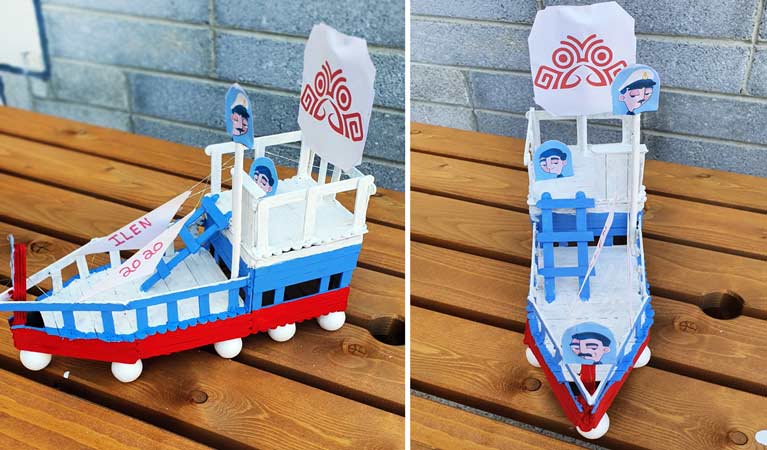 Another take on the model of the Ilen – somewhere in there are a lot of little planks which once thought they were going to be in a lollipop
Another take on the model of the Ilen – somewhere in there are a lot of little planks which once thought they were going to be in a lollipop
Limerick Ketch Ilen’s Model Gets the Dubarry Boots On
Our story last week, about how Gary Mac Mahon of the restored trading ketch Ilen of Limerick has launched a unique ship’s model-making competition to express the Ilen spirit, has rung a bell in Ballinasloe in County Galway, at the headquarters of the international outdoor footwear and clothing company Dubarry of Ireland
The Ilen competition offers a prize of a €150 Amazon Gift Voucher for children (or children and their families) who can create a model which best captures the spirit of Ilen and her original crew with a simplified miniature of the ship based on a very re-purposed Tetra Pak carton, the other materials involved being hopefully available in any contemporary family home.
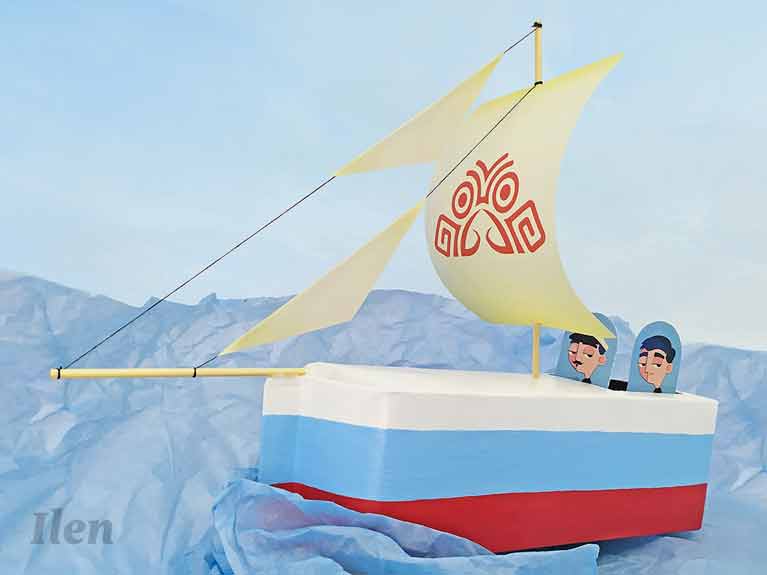 The essence of Ilen with her original skipper Conor O’Brien and his crew is expressed in this model based on a very re-purposed Tetra Pak carton
The essence of Ilen with her original skipper Conor O’Brien and his crew is expressed in this model based on a very re-purposed Tetra Pak carton
The idea is to provide the kind of imagination and ingenuity-testing challenge that will help us all get through the National Lockdown. And when the idea was revealed in Afloat.ie last week, Michael Walsh of Dubarry quickly responded: “What a great idea. I’d very much appreciate it if you would pass on to Gary Mac Mahon that Dubarry would very happily pitch in with a pair of Dubarry Boots or Deck Shoes for the winner”.
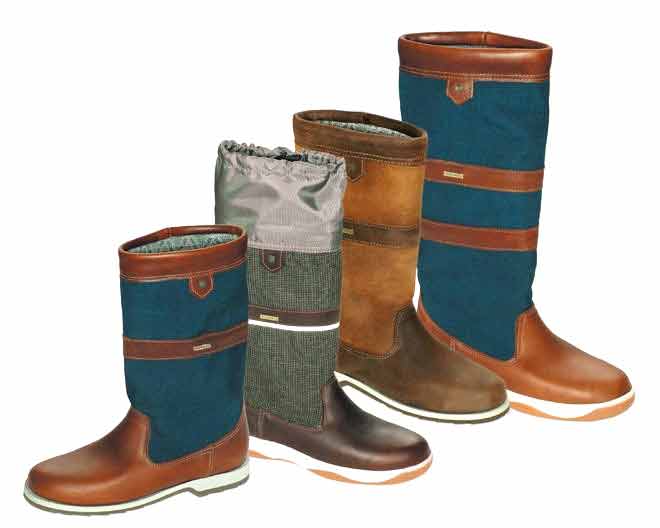 The Ilen Model competition has been greatly expanded with a choice of Dubarry Sailing Boots (above) and Dubarry Deck Shoes added to the prize
The Ilen Model competition has been greatly expanded with a choice of Dubarry Sailing Boots (above) and Dubarry Deck Shoes added to the prize
Now Dubarry of Ireland is Official Partners in the Ilen Project Model Competition, which makes the already good prize into a very worthwhile proposition. So folks young and old, once you’ve finished browsing the Dubarry range to find the Dubarry boot or deck-shoe of your choice, let’s get back to work on those models – the closing date is May 22nd.
Limerick Ketch Ilen DIY Kids’ Model Provides Handy Pint-Size Challenge for a €150 Prize
Junior and very junior sailors who’d like a special indoor Do-it-Yourself Challenge in these locked-in times will find something of special interest in the latest idea from current Irish Sailing Presidential Award holder Gary MacMahon of Limerick.
Gary received his award for his twenty-years of dedication in getting the 1926-built 56ft ketch Ilen of Conor O’Brien fame restored to such good seagoing order that, last summer, she voyaged to Greenland from Ireland and back, and collected other awards for that achievement.
This year the plan had been to have Ilen busy in and around the Shannon Estuary for the first half of the season, visiting all the local ports as part of her regular “Sailing into Wellness” programme. Then, on July 19th, she was to depart for Madeira to replicate the 1926 voyage Conor O’Brien made there with the ship, on his way to the Falklands, where Ilen was to spend her 40-year working life.
 Still seeing things differently through young eyes – Ilen’s delivery crew, and the ship herself
Still seeing things differently through young eyes – Ilen’s delivery crew, and the ship herself
But the COVID-19 lockdown has put that on hold for a year. However, one ray of hope is that if some sailing does resume in August, then Ilen may be able to make her first visit to the Cruinniu na mBad festival in Kinvara on Galway Bay – if it happens, this year’s is scheduled for 14th to 16th August.
Meanwhile, the Ilen team have been prevented from assembling in any way by current regulations in what would normally have been be a very busy time of joint effort for her fit-out programme, and thus the ship is effectively moth-balled in Limerick when she should already be sailing.
So in the meantime, one day Gary was idly observing a Tetrapak and got to thinking how it might be completely re-purposed to be the basis of a kids’ home project and competition for a €150 Amazon Gift Prize to create a pint-sized version of Ilen, complete with Conor O’Brien and the Cadogan cousins from Cape Clear, who crewed with him on the long voyage of 1926.
And yes, we know that a standard Tetrapak actually holds a litre, but for most of us “pint-size” has a much more resonant meaning. Take the basics off this pdf, and then you’ll just need a few little things that “should be readily available in a modern household….”
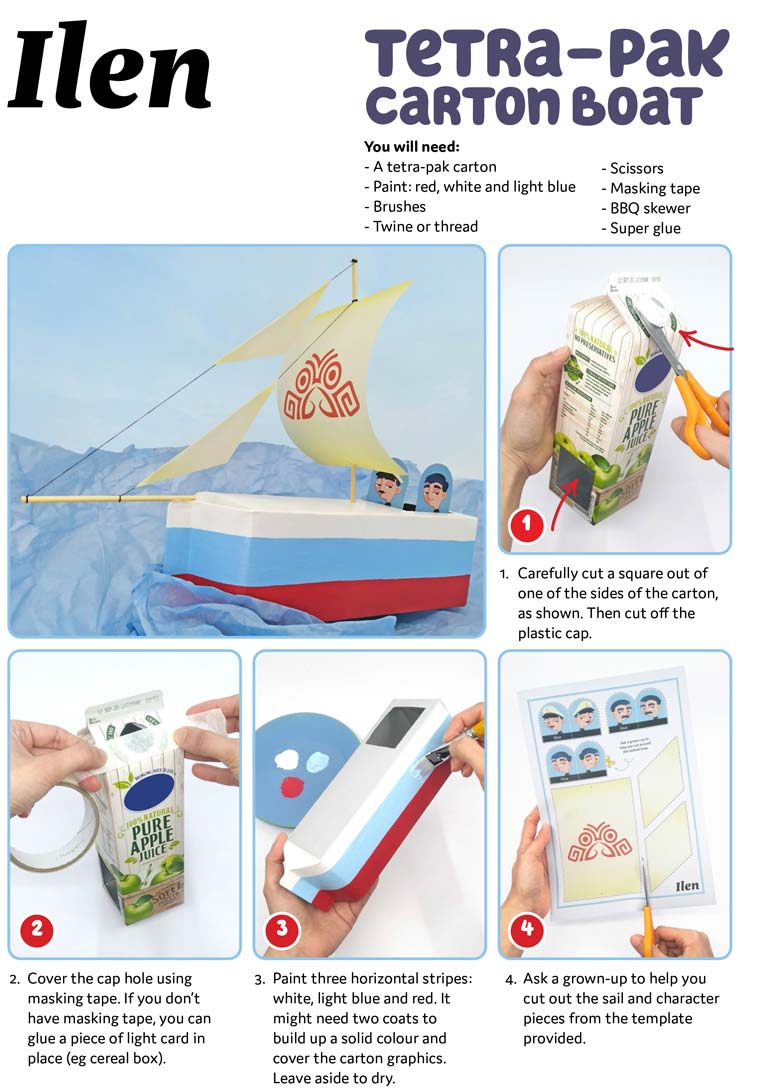 This is the cut-out-and-get-to-work department - Scroll down to the end of the article to download a PDF to make your own Ilen
This is the cut-out-and-get-to-work department - Scroll down to the end of the article to download a PDF to make your own Ilen
Oh yeah? We can see some mums and dads having kittens as they try to get their colour printer to work in order to create the cut-outs on a standard sheet of A4 paper, but not to worry, all will be well in the end. Have a care, though, when applying the specified Super-Glue – a kid-friendly paste from a squeezy tube or painted on with a sponge pen might be safer.
The key thing is to have the square-sail properly printed with the evocative Salmon’s Wake logo which set the tone for the Greenland voyage, and now seems to be the symbol for the entire Ilen project. Get that right, and then it’s Bon Voyage and good luck with the €150 prize. The competition ends on May 22nd.
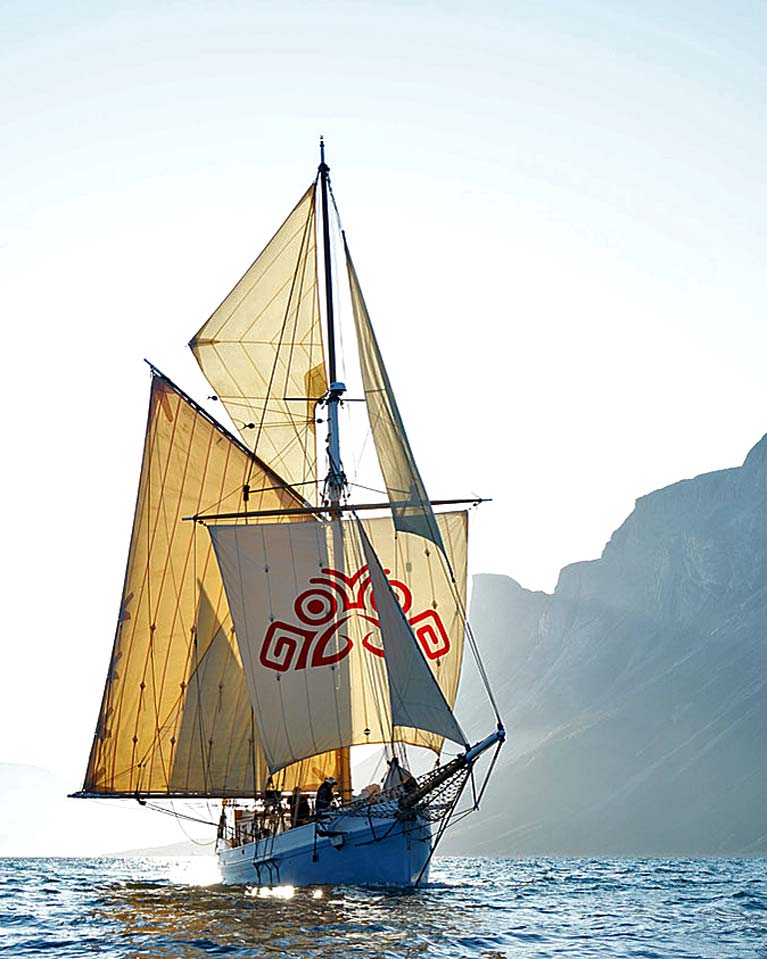 Award winner every which way – Ilen in Greenland. Photo: Gary Mac Mahon
Award winner every which way – Ilen in Greenland. Photo: Gary Mac Mahon






























